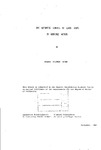THE AUTOMATIC CONTROL OF LARGE SHIPS IN CONFINED WATERS
| dc.contributor.author | BURNS, ROLAND STEPHEN | |
| dc.contributor.other | Faculty of Science and Engineering | en_US |
| dc.date.accessioned | 2013-11-13T11:46:17Z | |
| dc.date.available | 2013-11-13T11:46:17Z | |
| dc.date.issued | 1984 | |
| dc.identifier | NOT AVAILABLE | en_US |
| dc.identifier.uri | http://hdl.handle.net/10026.1/2689 | |
| dc.description.abstract |
The design and evaluation of a control system, which can be utilised for the automatic guidance of large ships in confined or restricted waters, is investigated. The vessel is assumed to be a multivariable system and it is demonstrated that a non-linear, time-varying mathematical model most accurately describes the motion of the hull, particularly in tight manoeuvres. A discrete optimal controller has been designed to control simultaneously track, heading and forward velocity. The system is most effective whilst operating under a dual-mode policy. It is shown that feedback matrix adaption is necessary to deal with changes in forward velocity and a form of gain scheduling is proposed. Active disturbance control is employed to counteract effects of wind and tide. An inertial navigation system, together with an optimal controller and filter, is installed on-board a car ferry model. Free-sailing tests show that the performance characteristics of the system are in accordance with theoretical predictions. The feasibility of implementation on a full-size vessel is considered. | en_US |
| dc.description.sponsorship | University College, London | en_US |
| dc.language.iso | en | en_US |
| dc.publisher | University of Plymouth | en_US |
| dc.title | THE AUTOMATIC CONTROL OF LARGE SHIPS IN CONFINED WATERS | en_US |
| dc.type | Thesis | |
| plymouth.version | Full version | en_US |
| dc.identifier.doi | http://dx.doi.org/10.24382/3427 |
Files in this item
This item appears in the following Collection(s)
-
01 Research Theses Main Collection
Research Theses Main


